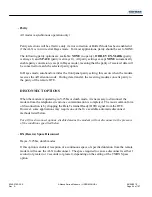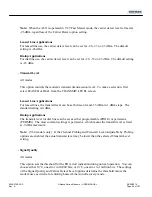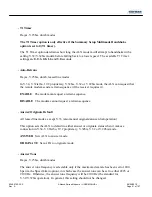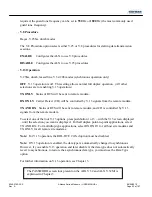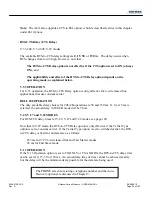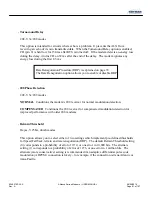
0049-2702-XXX Alliance Series Modems – USER MANUAL
08/05/2010
Rev. A
Page 50 of 197
-
Compromise Equalizers (COMPR EQ)
Hayes, V.25bis, dumb, leased line modes
(V.32/V.32bis, V.32terbo and V.33 modes only)
It is usually not necessary to adjust the modem’s compromise equalizers. However, in the
event that an equalizer adjustment is needed, any of four types of compromise equalization can
be selected:
Type I
(T-I on the LCD),
Type II
(T-II),
Type III
(T-III) and
Type IV
(T-IV).
The equalizers (located in the modem’s transmitter) can also be turned
OFF
.
Where line conditions are atypical, it may be necessary to adjust the equalizers to optimize the
signal quality. If adjustment is necessary, refer to the quality screen for a relative indication of
the signal quality.
-
Trellis Code
Hayes, V.25bis, dumb, leased line modes
(V.32bis, V.32terbo and V.33 modes only)
The modem’s IUT-T compliant trellis coder provides enhanced performance. It is normally
enabled at speeds of 7200 bps and above, but at 9600 bps or higher, may be negotiated off by a
modem that is not equipped with a trellis coder. The trellis code option allows the user to
enable or disable the trellis coder.
-
Transmitter Clocking
All modes (synchronous operation only)
This option selects one of three possible sources for the transmitter timing signal:
INTERNAL
The timing of the modem and data terminal transmitting circuits is provided by
an internal clock within the modem.
RECEIVED (RX-CLK)
The timing of the data received from the remote modem is used to
control the timing of the transmitted data. This timing mode is used if the modem’s transmit
timing must be controlled by a remote source.
EXTERNAL
The timing of the modem and data terminal transmitting circuits is synchronous
to an external clock from within the data terminal and is provided to the modem via the DTE
connector pin 24. This mode of clocking is used if the DTE must be in control of the modem’s
transmit timing. The modem’s minimum and maximum speed (data rate) must be set to
approximately the same speed as the DTE clock, using the Speed Limit option.









